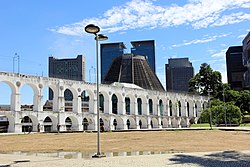Lapa (Rio de Janeiro)
| Lapa | |
|---|---|
| Neighborhood | |
 |
|
| Location in Rio de Janeiro | |
| Coordinates: 22°54′49″S 43°10′54″W / 22.91361°S 43.18167°WCoordinates: 22°54′49″S 43°10′54″W / 22.91361°S 43.18167°W | |
| Country |
|
| State | Rio de Janeiro (RJ) |
| Municipality/City | Rio de Janeiro |
| Zone | Centro |
Lapa is a neighborhood in the city of Rio de Janeiro, in Brazil. It is located in the centre of Rio and is famous for its historical monuments and nightlife.
The neighborhood is home to the Arcos da Lapa, an impressive aqueduct constructed in the mid-18th century by colonial authorities. Another important historical attraction is the Passeio Público, the first public park of the city, built in the 1780s.
Since the early 1950s, Lapa has been known for its lively cultural life where there is a concentration of many restaurants and bars where Brazilian artists and intellectuals would meet. It was, and still is, famous for its many restaurants, bars and clubs where the various forms of Brazilian music can be appreciated, like the Asa Branca bar and the Fundição Progresso. The Sala Cecília Meireles, an important venue for chamber music, is also located in Lapa.
The neighborhood of Lapa, Rio de Janeiro, known as the cradle of bohemian Rio is also famous for its architecture, starting with the Arcos - known as the Arcos da Lapa, constructed to act as conduit in the days of colonial Brazil and now serve as a signal for the cable cars that climb the hill of Santa Teresa.
The Carioca Aqueduct is considered the architectural work of greater importance of Old Rio and one of the main symbols of the city. The impressive Roman-style building is 17.6 meters high, 270 meters long and 42 arches that connect the neighborhood of Santa Teresa to Morro de Santo Antônio. The Carioca Aqueduct was built in 1723, during the colonial Brazil, and was intended to lead water from the Carioca river height Morro do Desterro, on Santa Teresa for the Morro de Santo Antônio. The work would help solve the problem of water shortage in the city. Problem that was already old. Studies to bring the waters of the Carioca river to the city began in the early years of the seventeenth century, but the works of installing water pipes in Rio de Janeiro did not start until a century later.
In recent times the landscape of Lapa has been significantly amended. Where was the Square of the Brazilian armed forces (a square attached to the arches) today there is a huge Circo Voador. Arches Street, which crosses the aqueduct, was via a building occupied by trees, including the Progress Casting, which is now a venue. The neighborhood is born at the end of the south, where the road of glory becomes Rua da Lapa. Also on the border of Santa Teresa, climbing its slopes and the small neighborhood of Fátima.
...
Wikipedia


